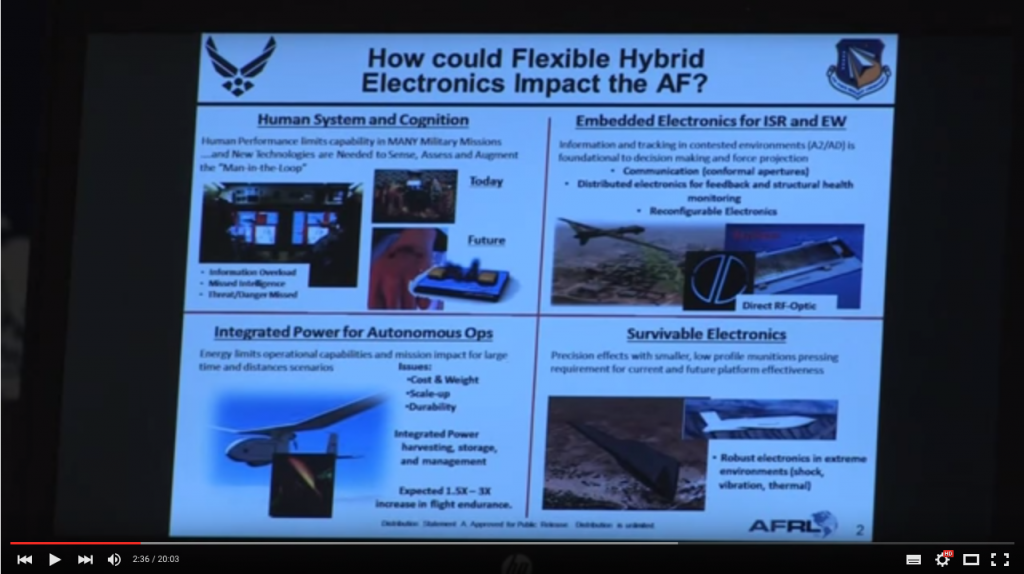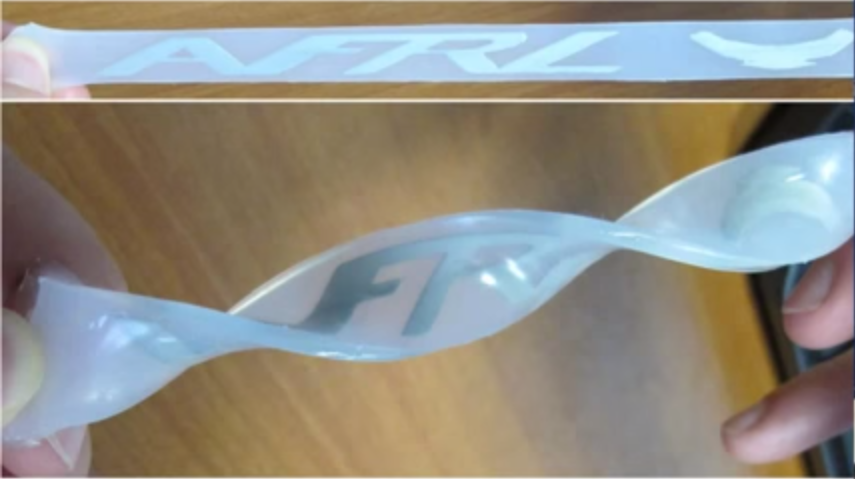At the 2015 meeting of the American Chemical Society, Dr. Benjamin Lever introduced research that is being conducted at the Air Force Research Lab at the Wright-Patterson Air Force Base in the area of flexible electronics. The idea being pursued is that flexible semiconductors could be printed directly onto a substrate, such as a flexible polymer-based plastic with the whole contraption being no more than a few nanometers in thickness. The devices would then have anywhere between a 30% stretching limit (comparable to human skin) to a 100% limit (meaning they could be folded). The capacity for stretching would depend on the types of electronics that needed to be included but because of the printing technique, they are nearly always superior to inorganic electronic components. The applications for such a technology are only limited by the imagination. Dr. Lever explained:
“Relatively simply, this is the idea of taking high performance, yet also flexible electronic devices, these could be semiconductors for example, that could be made very thin, just a few nanometers thick so that they are highly flexible, combining those with other components such as batteries or sensors and interconnects that could be printed and putting this combination of devices onto a nontraditional substrate, so this could be a plastic that could be stretchable or conformable.”
One particular application of interest to Dr. Lever is the possibility for creating a patch that could be worn like a bandaid on the shoulder of a member of the Air Force that would be able to collect and transmit information about hydration levels, fatigue, or signs of cognition impairment. That information could be used either by a commander or by the soldier her/himself in order to monitor their overall condition. The applications of these types of devices are not limited to use in military scenarios but could also prove to be extremely useful in medical and consumer applications.
Another area of interest is in the creation of hybrid flexible electronics that are conformable to the shape of aircraft wings or to the inside of an airplane. An ability to print such devices at a minimum thickness would allow for them to  be attached to the wing without creating additional drag or deforming the shape of the wing, which would result in reducing its performance. These devices could be used to attach an antenna or other communication capability easily to a given aircraft and it would also be easy to remove, replace, or reposition.
be attached to the wing without creating additional drag or deforming the shape of the wing, which would result in reducing its performance. These devices could be used to attach an antenna or other communication capability easily to a given aircraft and it would also be easy to remove, replace, or reposition.
As you can imagine, the survivability of electronic devices under the extreme conditions to which they are regularly submitted as part of both routine and special operations in the Air Force poses a challenge. The creation of a generation of soft electronics could enhance the longevity of important devices that currently suffer damage after exposure to high shock environments such as subjection to 20k – 50k of G-force or introduction into a variety of extreme temperatures. Rigid boards experience failure of the interconnects either through fatigue or by becoming brittle, leading to in-situ failure of components.
Realizing that a weapon, when it hits the ground, experiences approximately 20k g’s of force, it becomes apparent that having electronics that can survive such an impact is vital to continued performance of the weapon and could be truly the difference between life and death for an individual needing to utilize that particular weapon. With traditional electronics, such an impact would cause the components to become violently detached from the circuit board whereas under testing conditions, a flexible circuit on a flexible substrate can survive the same exact conditions.
 One of the innovations that will allow for printed electronics to be flexible is the use of gallium liquid metal alloys, developed by Michael Dickie at North Carolina State University. These alloys work in a similar fashion to liquid mercury in that they have a strong drive to gather together. The wires that are required for electronics limit their flexibility because they break under the kind of stresses necessary for true flexibility. Creating ‘wires’ with liquid gallium alleviates the need for solid metal wiring as it can conform to a continually moving surface. It acts as an interconnect that will simply stretch to fill the necessary space as the electronics are reshaped. Dr. Level summed up the benefits of this research:
One of the innovations that will allow for printed electronics to be flexible is the use of gallium liquid metal alloys, developed by Michael Dickie at North Carolina State University. These alloys work in a similar fashion to liquid mercury in that they have a strong drive to gather together. The wires that are required for electronics limit their flexibility because they break under the kind of stresses necessary for true flexibility. Creating ‘wires’ with liquid gallium alleviates the need for solid metal wiring as it can conform to a continually moving surface. It acts as an interconnect that will simply stretch to fill the necessary space as the electronics are reshaped. Dr. Level summed up the benefits of this research:
“There are a lot of applications that the Air Force sees for this. And, of course, all of us who use consumer electronics will also benefit from it, from having electronics that can survive a fall but not having the thick packaging that’s on all our devices now. We could have very thin electronics that could conform to the shape of our bodies but are also very survivable and rugged.”
The video of Dr. Lever’s presentation has been released on youtube and includes a series of questions that he answers which further elaborate on specific applications.
Subscribe to Our Email Newsletter
Stay up-to-date on all the latest news from the 3D printing industry and receive information and offers from third party vendors.
You May Also Like
Profiling a Construction 3D Printing Pioneer: US Army Corps of Engineers’ Megan Kreiger
The world of construction 3D printing is still so new that the true experts can probably be counted on two hands. Among them is Megan Kreiger, Portfolio Manager of Additive...
US Army Corps of Engineers Taps Lincoln Electric & Eaton for Largest 3D Printed US Civil Works Part
The Soo Locks sit on the US-Canadian border, enabling maritime travel between Lake Superior and Lake Huron, from which ships can reach the rest of the Great Lakes. Crafts carrying...
Construction 3D Printing CEO Reflects on Being Female in Construction
Natalie Wadley, CEO of ChangeMaker3D, could hear the words of her daughter sitting next to her resounding in her head. “Mum, MUM, you’ve won!” Wadley had just won the prestigious...
1Print to Commercialize 3D Printed Coastal Resilience Solutions
1Print, a company that specializes in deploying additive construction (AC) for infrastructure projects, has entered an agreement with the University of Miami (UM) to accelerate commercialization of the SEAHIVE shoreline...





























